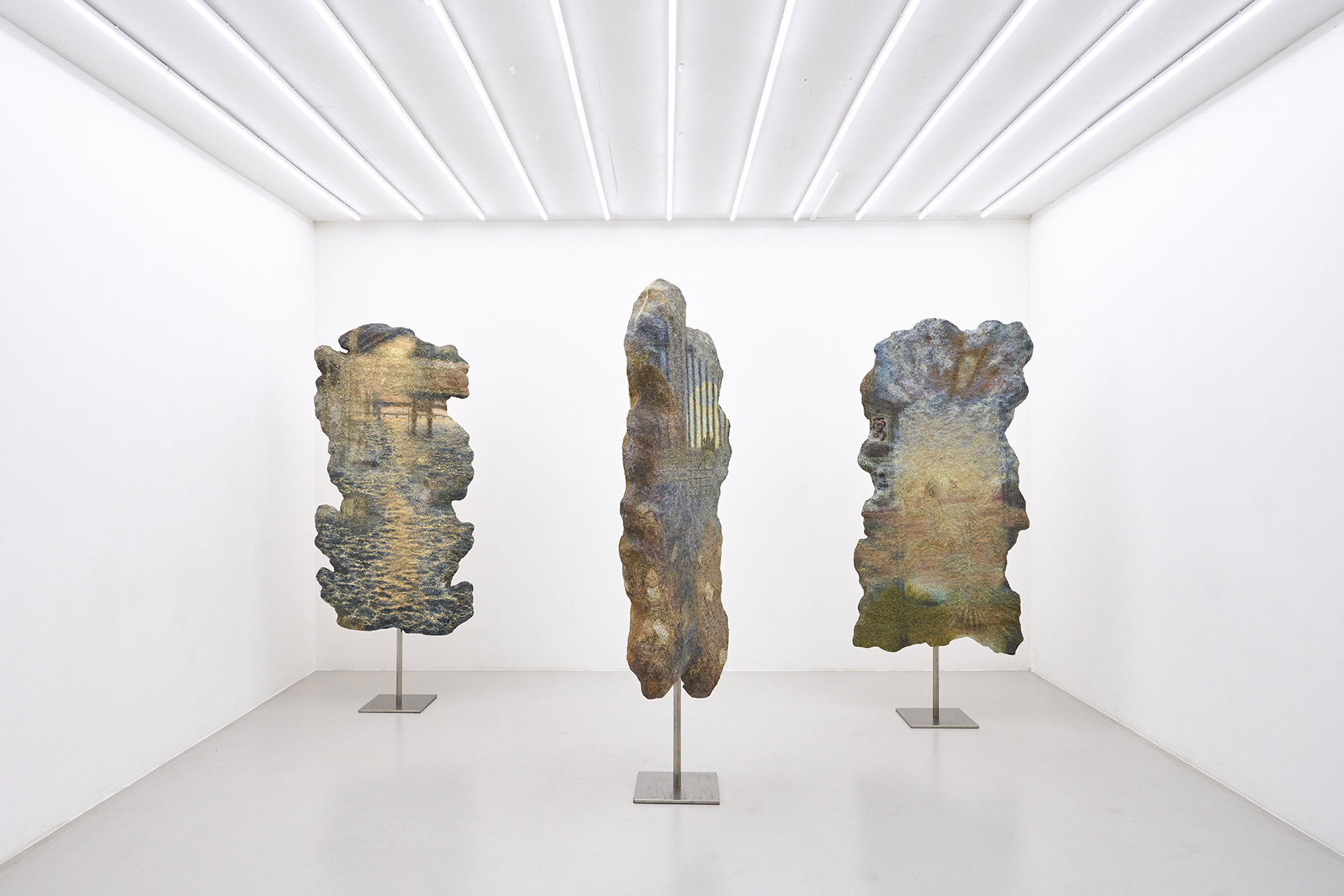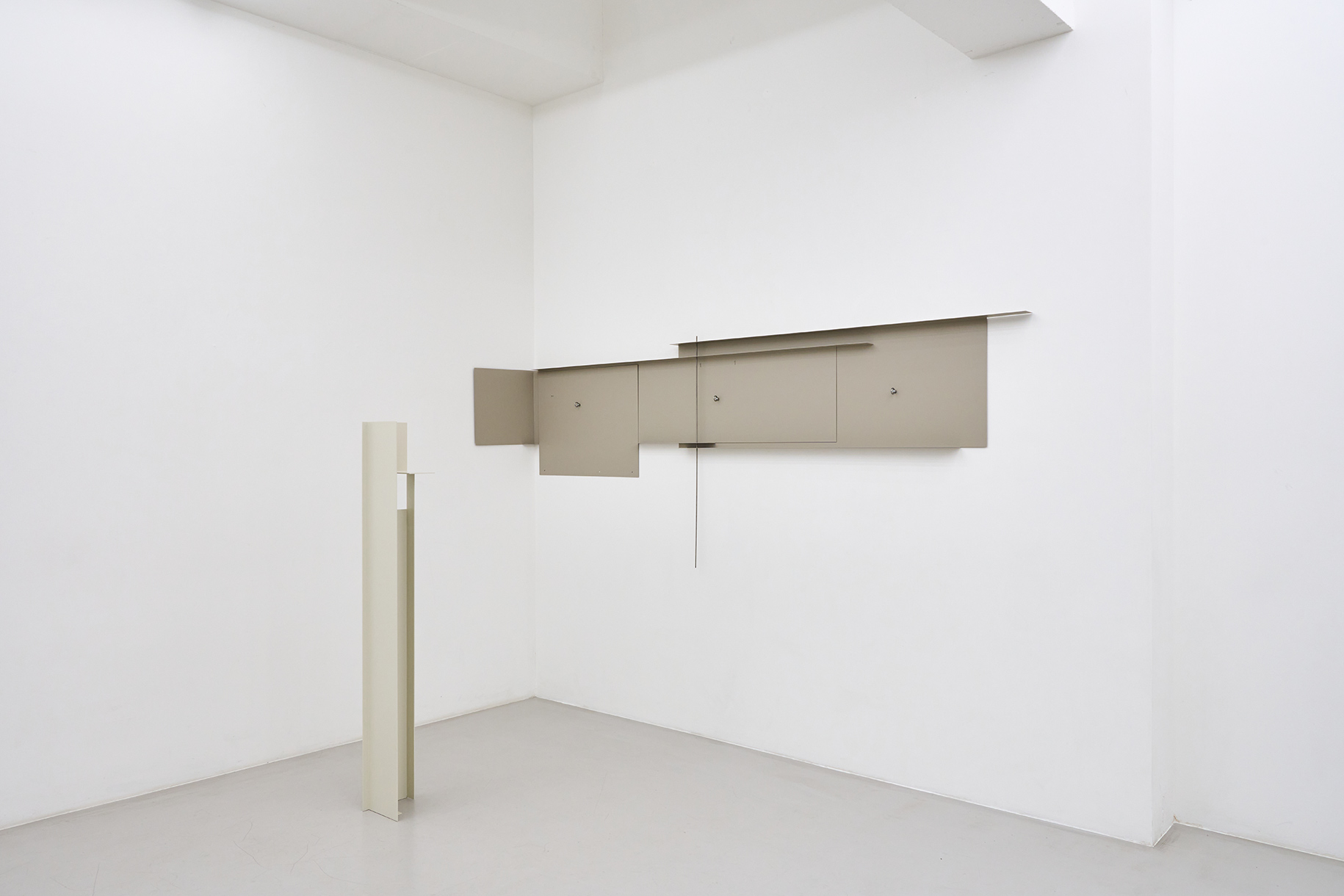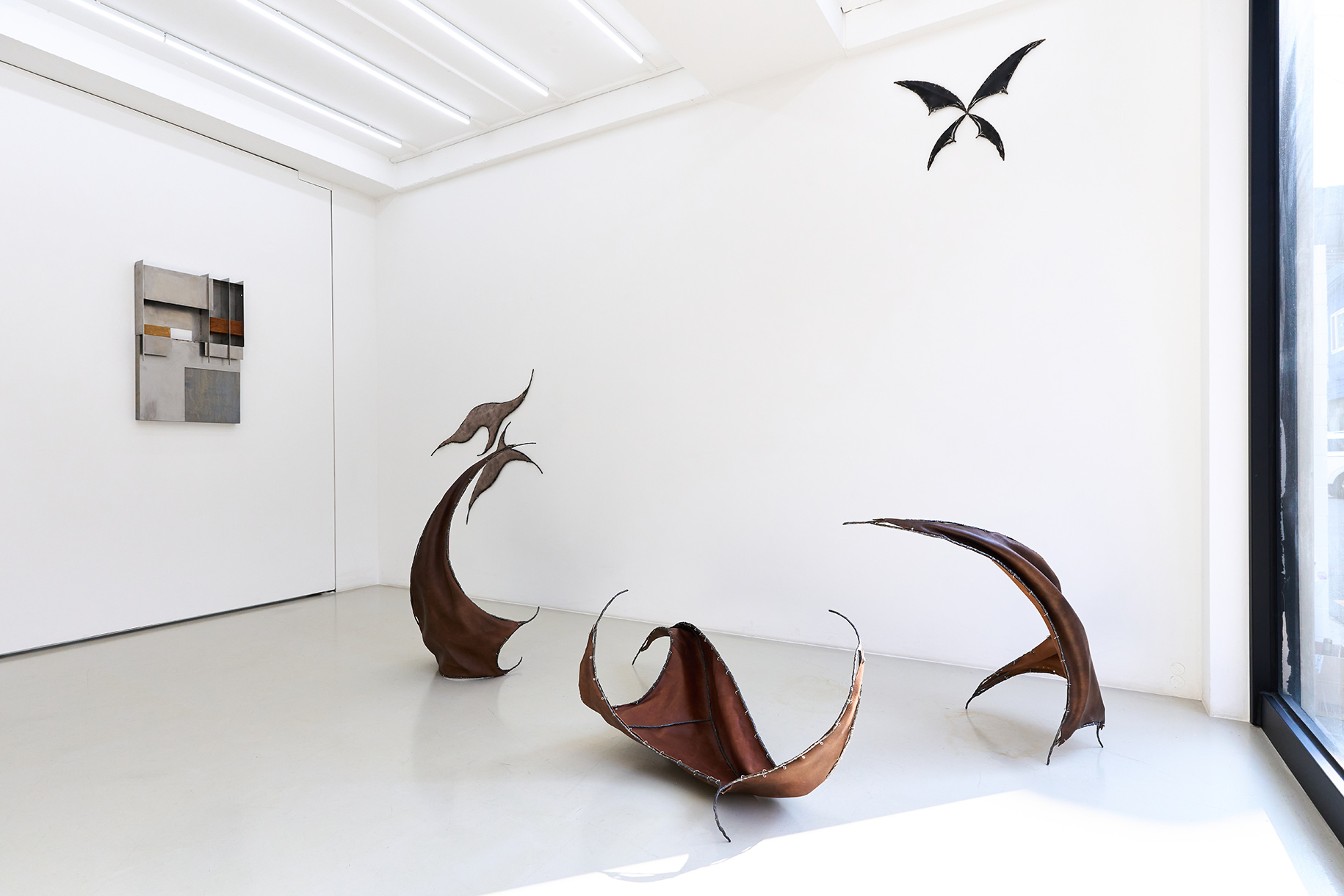Exhibition
The Wild Bunch vol.2
와일드 번치 vol.2

INSTALLATION VIEW “The Wild Bunch vol.2”, 2025. Courtesy of the Artist and ThisWeekendRoom.
Humanity is passing through an ironic era in which the boundary between physical reality and immaterial illusion is dissolving, and the conditions of the real world are increasingly influenced by the online environment. The exhibition The Wild Bunch vol.2 highlights four emerging artists whose material explorations and conceptual discussions are grounded in the specificity of this moment. Moon Mean, Yeun Song, Yongbin Lee, and Soohyun Chung intentionally step away from the commercialized logic of visual art forms such as sculpture, painting, and installation. As a generation of digital natives, they focus on reimagining the layers of images they have encountered in and around media reality into distinctive forms and concepts, instead of sinking into the illusion of hyperreality. The artists engage with information stored on smartphones or circulating online, incorporating the rules and limits of architecture, manufactured goods, animation derivatives, and the effects of digital editing programs. This process entails the introduction of their own formative logic and characteristic textures. For example, they create the surfaces on which the images are placed by hand, or by mixing different materials, and achieve a variable state in which each element can be freely combined or disassembled as needed. Sharing a loose interest in virtual and real places, the creation and destruction of space, and the convergence and dislocation of physical constraints, their works do not converge within the categories of traditional media. Instead, they proliferate and transform from there. This exhibition invites us to perceive the environmental features of today’s world-shaping and anchoring our senses-and aims to capture the diversity of visual languages that emerge from them.
Using homemade materials, Moon Mean creates works that reconstruct large and small events that happen to him and his surroundings. He prepares solid and light atypical blanks by layering macerated Hanji and paints on them with turbid pigments he calls metallic tempera. Like the moon hanging over a smudged horizon, the silhouette of the ceiling in his room at night with unknown time, the ripples in the river as someone else would have seen, scenes with no name or owner are slowly transformed by the artist’s hand into uneven images. For him, reality is an opaque mass of too many superimpositions to grasp clearly. Fragments of images stored in his phone or glimpsed on social media overlap and intermingle in a foggy field of faded light, transforming them into abstractions. Flowing on the edges of painting and sometimes borrowing from sculpture and installation, Moon’s work questions the gap between reality and fiction, truth and misunderstanding, memory and fact.
Yeun Song creates her work around the logistical rules and constraints of storing and moving artworks. Since the pandemic, it has become tricky to move something geographically. This is contrary to the indiscriminate dissemination of images and information, that reminds us of entrenched national boundaries and physical limitations. The artist designed the sculpture pieces that can be assembled like a puzzle on standardized shipping pallets. Each piece can be attached to the other to form one large work or broken down into smaller fragments. The aesthetic order of the objects made up of industrial materials and paints is an internalization of their given environmental characteristics. Rather than being trapped within limited possibilities, the raw materials exist in a flexible form, loaded with active possibilities through the artist’s active pre-design. These versatile sculptures soon produce their rhythms and begin to establish a relationship with the place where they are placed.
Yongbin Lee’s works adopt the sculptural principles in digital programs. The three-dimensional objects perceived beyond the screen exist primarily as a thin skin of different textures placed over a framework established by imaginary lines. The artist recognizes the frames and shells used in this methodology are conceptual tools that do not exist in reality. By intentionally making this fact prominent in his work, Lee aims to reveal the contemporary reality of a mixture of immaterial and material components. Fragments of images drawn from the digital logic ecosystem of comics, animation, and games are replaced by a combination of tough leather and welded steel frames. The objects assembled with disparate elements are unable to return to the screen and begin life on Earth as hybrids with a vertiginous balance and weight. His work becomes an indicator of how human perception is crossbred and intertwined as it traverses the dimensions of online and offline.
Soohyun Chung places her artistic perspective between the world created on the screen and the zone her body touches here and now. For the artist, who has been familiar with 3D rendering programs since childhood, real-world objects with their unique modes of operation(catapults, hot air balloons, ladders, etc.) are triggers for her to imagine expanded and unknown landscapes. Chung designs architectural structures through the computer that maximize the microscopic features of the observed objects and then transfer them into real space. The space cultivated within the digital program transforms into an artwork, blending two-dimensional flat images with three-dimensional frames. During this process, the artist’s imagination is seamlessly integrated. This arbitrary construction, which she calls an “imaginary playground,” does not rely on a rigorous mechanism. Instead, the sensations generated by the objects and environments that the artist encounters in her daily life become the nourishment that determines the gravity of the screen and grows into a surreal landscape.
TextㅣJihyung Park (Curator, ThisWeekendRoom)

INSTALLATION VIEW “The Wild Bunch vol.2”, 2025. Courtesy of the Artist and ThisWeekendRoom.
인류는 물리적 실체와 비물질적 환영 사이의 벽이 무너져 마침내 실재계의 조건이 온라인 환경에 의탁하게 되는 아이러니한 시대를 지나고 있다. 전시 《와일드 번치 vol.2》는 이러한 시기적 특수성 위에서 재료적 탐구와 개념적 논의를 시도하는 신진 작가를 조명한다. 문민, 송예은, 이용빈, 정수현은 조각, 회화, 설치 등 시각 예술 양식의 상용화된 논법에서 의도적으로 물러난다. 디지털 네이티브인 네 명의 작가는 하이퍼 리얼리티의 환상 안으로 무기력하게 침몰하는 대신 미디어 현실 안팎에서 경험한 다양한 이미지의 겹을 특유의 형식과 개념으로 재창안하는 데 집중한다. 그들은 스마트폰에 저장되거나 온라인에 떠도는 정보, 건축물과 공산품의 규칙과 한계, 애니메이션의 파생물, 디지털 편집 프로그램의 효과 등을 취득하고 가공한다. 이 과정에서 자신만의 조형적 논리와 특징적인 질료의 도입이 수반된다. 이미지가 올라서는 표면을 직접 빚어내거나 상이한 물질을 접붙이고, 필요에 따라 각 요소가 자유롭게 결합하거나 해체될 수 있는 가변적 상태를 확보하는 식이다. 가상과 현실의 장소성, 공간의 생성과 유실, 물리적 제약의 수렴과 탈주라는 느슨한 관심사를 공유하는 이들의 작품은 전통적 매체의 범주 안으로 수렴하기보다 그곳에서부터의 확산과 변주를 도모하고 있다. 본 전시는 우리의 감각이 닻을 내리고 있는 오늘의 환경적 특징이 무엇인지 인식하게끔 유도하고, 그로부터 발현된 시각 언어의 다양성을 포착하는 장이 되고자 한다.
문민은 직접 만든 재료들을 이용해 자신과 주변에서 일어나는 크고 작은 사건들을 재구성한 작품을 제작한다. 그는 닥죽을 겹겹이 쌓아 단단하고도 가벼운 비정형의 공백을 준비하고, 그 위에 금속성 템페라라고 이름 붙인 탁색의 안료로 그림을 그린다. 뭉개진 수평선 위에 걸린 달, 시간도 알 수 없는 밤 방에 누워 바라보았던 천장의 실루엣, 나 대신 누군가 보았을 강물의 주름. 이름도 주인도 없는 장면은 아주 천천히 작가의 손을 거쳐 요철이 있는 이미지가 된다. 그에게 현실은 너무 많은 것들이 중첩되어 한눈에 명료하게 파악할 수 없는 불투명한 덩어리와 같은 것이다. 핸드폰에 저장되어 있었거나 소셜미디어에서 우연히 스쳐 갔던 이미지 단편들은 빛이 바랜 듯한 안개 속의 장에서 겹쳐지고 뒤섞여 추상에 가까운 화면으로 변모한다. 회화의 가장자리를 타고 흐르며 때로 조각과 설치의 용법을 차용하는 그의 작업은 실재와 허구, 진실과 오독, 기억과 사실 사이의 낙차에 대해 질문한다.
송예은은 완성된 작품을 보관하고 이동시키며 맞닥뜨린 물류 체계의 규율과 제약을 작품으로 구조화한다. 팬데믹 이후 사물을 지리적 틀 너머로 이동시키는 것은 부쩍 까다로운 일이 되었다. 이는 이미지와 정보가 무차별적으로 전파되는 세태와 상반되며 공고한 국가적 경계와 물리적 한계를 상기시킨다. 작가는 규격화된 물류 운송 파렛트 위에서 퍼즐처럼 맞춰 조립이 가능한 조각을 구상했다. 각 부분은 서로 결착되어 하나의 큰 작품이 되거나 작은 파편으로 나누어질 수 있다. 공업용 자재와 도료로 만들어진 대상의 미적 질서는 주어진 환경적 특성을 내재화한 것이다. 단단한 원료들은 제한된 가능성안에 갇히기보다 작가의 적극적인 사전 설계를 통해 능동적인 가능성을 탑재한 유연한 모습으로 존재한다. 이 영리한 조각은 이내 스스로의 리듬을 생산하며 자신이 새롭게 놓일 장소와 관계를 맺기 시작한다.
이용빈은 디지털 프로그램에서 작동하는 조형적 원리를 차용한 결과물을 도출한다. 스크린 너머로 인지되는 3차원의 대상은 주로 가상의 선으로 세워진 골조 위로 질감이 다른 얇은 스킨을 씌워 양감을 조성하는 식으로 존립한다. 작가는 이 방법론에 사용되는 프레임과 껍데기가 실제로는 존재하지 않는 관념적인 도구라는 점을 인지한다. 그는 이 사실을 자신의 작품에서 의도적으로 도드라지게 만듦으로써 비물질과 물질적 성분이 혼재된 동시대의 실상을 드러내고자 한다. 만화, 애니메이션, 게임 등 디지털 논리로 구현된 생태계에서 차출된 이미지의 파편은 질긴 가죽과 용접한 철제 프레임의 조합으로 치환된다. 이질적인 요소들의 결합으로 태어난 대상은 다시 스크린 안으로 회귀하지 못하고 이 땅에서 불온한 균형과 무게를 가진 혼종체로서 삶을 시작한다. 그의 작업은 온라인과 오프라인의 차원을 횡단하는 인간의 지각이 어떻게 교배되고 얽혀있는지 반영하는 지표가 된다.
정수현은 스크린 안에서 생성되는 세계와 지금 여기에서 그의 몸이 접촉하는 지대 사이에 자신의 예술을 놓는다. 어릴 적부터 3D 렌더링 프로그램에 익숙했던 작가에게 독자적인 작동 방식을 가진 현실의 사물(투석기, 열기구, 사다리 등)은 확장된 미지의 경관을 상상하게끔 하는 도화선이다. 그는 관찰한 대상의 미시적인 특징을 극대화한 건축 구조물을 컴퓨터 안에 설계하고 이를 실제 공간으로 옮겨 오기로 한다. 디지털 프로그램 안에서 배양된 공간은 2차원의 평면 이미지와 3차원의 프레임이 결합한 형식의 작품이 되는데, 이 변환의 과정에서 작가의 상상력이 가미된다. 말하자면 그가 ‘가상의 놀이터’라고 칭하는 이 자의적 시공에는 엄격한 기제가 요구되지 않는다. 대신 행위자인 작가가 일상에서 마주했던 사물과 환경에서 기인한 감각이 이곳의 중력을 결정하는 자양분이 되어 초현실적인 풍경으로 자라난다.
글ㅣ박지형 (디스위켄드룸 큐레이터)

INSTALLATION VIEW “The Wild Bunch vol.2”, 2025. Courtesy of the Artist and ThisWeekendRoom.
2025. 03. 14. (Fri) – 04. 12. (Sat)
ThisWeekendRoom